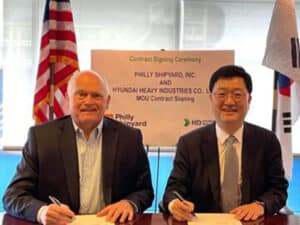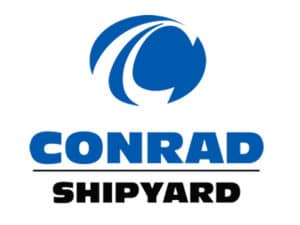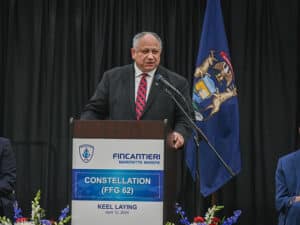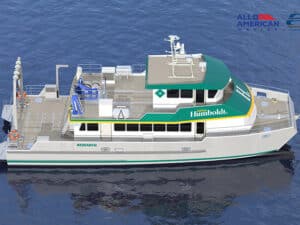
Recent workboat deliveries have enhanced fuel efficiencies in mind
Written by Heather Ervin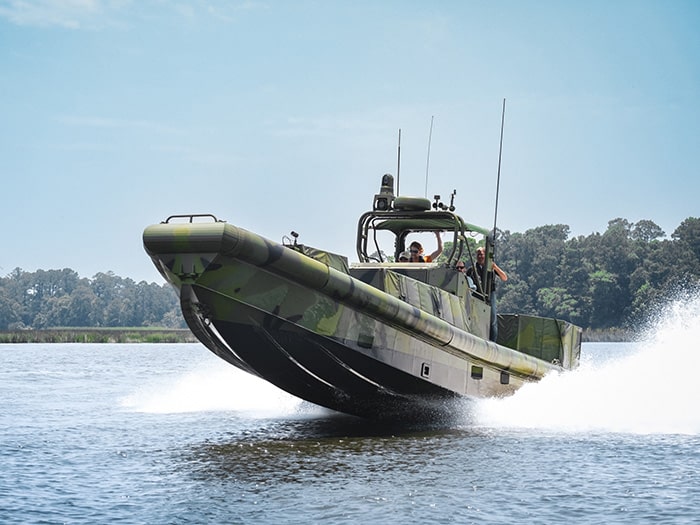
The six custom-designed riverine patrol boats are uniquely engineered to successfully operate in shallow and hazardous waters. (Credit: Silver Ships)
Coming off the heels of the International Workboat Show last month, one thing is certain: an emphasis on green operations was all over the showroom floor. Workboats, including patrol and pilot boats—the focus of this feature—was no exception.
In October, Silver Ships completed the construction of six riverine patrol boats (RPB) under a contract award worth $6.12 million from the Naval Sea Systems Command. The vessels were designed and constructed as a part of the U.S. Foreign Military Sale program and will benefit a Pacific region ally. Each RPB was inspected and accepted by the Navy and await overseas shipment.
The six custom-designed riverine patrol boats are uniquely engineered to successfully operate in shallow and hazardous waters. The rugged, 40-foot center-console patrol boats are powered by twin Yanmar 440 hp. engines and Hamilton waterjets. Traveling at more than 30 knots, the boats reach necessary speeds with limited operating noise to remain stealthy.
The workboats are armed and armored and have been designed to carry 20 personnel, or a typical crew of six with 14 additional troops and cargo. Riverine patrol boats are used for foreign and joint force operations on river, coastal and open ocean patrol and interdiction duties. Typically, they are used for counterterrorism and lawlessness but can also be used for humanitarian assistance, medical evacuation, command and control, counter-drug, search and rescue and many other missions.
Foiling Technology for Patrol Boats
Another patrol boat gaining traction is Artemis Technologies’ EF-20H patrol vessel, which like all Artemis vessels, is foilborne. The Belfast, Northern Ireland-based company has designed the patrol boat with speeds up to 40 knots. Combined with crew comfort and stability, its Artemis eFoiler Patrol Range is designed specifically to deliver enhancements to patrol boat operations for governments, coast guards and security organizations.
The stable deck provides a solid platform for crew members to perform their duties effectively, even in challenging sea conditions. It minimizes the risk of accidents and injuries by reducing the impact of waves and swells on the vessel’s stability, allowing crew members to maintain their balance and focus on their tasks.
The 20-meter patrol boat has a 3.1-meter draft when its foils are deployed. When the foils are detracted, it has a 1.2-meter draft.
In September, Artemis Technologies announced that it had taken its all-electric foiling craft technology into the pilot boat sector, unveiling the EF-12 pilot. Artemis first demonstrated its foiling technology on the water in June 2022, when it put its eFoiler foiling workboat through its paces in Belfast Harbor. Since then, it has launched crew transfer vessel and passenger ferry models.
With a top speed of 32 knots and a foiling range of 55 nautical miles, the latest 100% electric addition to the Artemis portfolio was developed following interest from pilot boat operators around the world. Just as it did with the EF-20H patrol boat, crew comfort and stability were top of mind during the design, while meeting the specific requirements unique to the challenges of pilotage operations. Artemis says that the workboat’s ability to actively stabilize its roll, pitch, and heave during the transfer of pilots greatly reduces the risks associated with this critical but potentially hazardous operation.
Development of the workboat was supported by the U.K. Department for Transport’s Clean Maritime Demonstration Competition, with Artemis Technologies working closely in partnership with Belfast Harbor on a feasibility study of the potential of the Artemis eFoiler technology to decarbonize global pilot boat operations.
The company is a spin-off from the Artemis Racing team that competed in the America’s Cup, of which its founder, two-time Olympic champion Dr. Iain Percy OBE, is a four-time veteran.
“During the 8-month feasibility study we undertook real world data collection and analysis of Belfast Harbor’s pilot operations allowing us to understand typical pilot vessel duty cycles and operational requirements,” said Percy. “An exact virtual copy of Belfast Harbor’s existing pilot vessel was created and input into our digital twin toolchain allowing a virtual study comparing the Artemis EF-12 Pilot design against this real-world operational pilot vessel.
“Analysis of the data collected during our research and testing has indicated that the Artemis EF-12 Pilot will deliver significant cost savings over the expected lifespan of a vessel, prevent the release of CO2 emissions, and reduce the relative motions between pilot vessel and ship during pilot transfer, when compared to the current vessels working in this sector of the ports industry.
Mississippi River Pilot Boats
Closer to home for those of us in the U.S.—although many of these European operations are looking to compete in the North American market—Seattle-headquartered Snow & Company Inc. was awarded a contract back in March to build two 50-foot pilot boats for the Metairie, La.-headquartered Crescent River Port Pilots’ Association.
Like the two 64-foot pilot boats delivered to the Savannah Pilots last year, the two just-ordered boats have been designed by Camarc Design, U.K.
The all-aluminum vessels are designed with a refined hull with enhanced fuel efficiencies and reduced slamming accelerations, which provide excellent all-around seakeeping capabilities, and a pilot-specific shape to facilitate safe boarding operations.
The vessels will be powered by twin Volvo D13-800 EPA Tier 3 marine diesel engines, Hamilton Twin HJ403 WaterJets with two-station AVX express controls, and Twin Disc MGX5136SC marine gears. This combination allows for high performance maneuverability with an expected top speed of 35 knots.
“The Crescent River Port Pilots are very excited about contracting with Snow & Company, Inc. to build two custom Camarc Design jet powered pilot boats to safely service pilot transfers to deep draft vessels on the lower Mississippi River at Pilottown,” said Capt. E. Michael Bopp, president of the Crescent River Port Pilots’ Association.
New CARB Requirements
At the start of this year, the San Francisco Bar Pilots engaged naval architecture and marine engineering firm Glosten to design new station boats that will meet the new California Air Resources Board (CARB) harbor craft emission requirements.
The CARB regulations limit emissions below what is required by EPA for Tier 4 and must be met for any vessel considered a harbor craft by CARB operating in California harbor and coastal waters. They were adopted despite industry objections from several organizations, including the American Waterways Operators.
“These new vessels will allow the Bar Pilots to continue to provide safe navigation throughout the San Francisco Bay and further our mission of environmental stewardship,” said John Carlier, president of the San Francisco Bar Pilots.
Glosten worked with San Francisco Bar Pilots in 2007, providing engineering support and construction oversight of the third San Francisco class 104-foot pilot station boat, Drake.
Glosten’s support of the new station boats includes a propulsion feasibility study, which is currently underway, and a contract design package.
San Francisco Bar Pilots is slated to be the first pilot association in California to acquire vessels that will meet CARB’s Commercial Harbor Craft Regulation. The first two station boats are expected to be in service by the end of 2024, with the third in service by the end of 2025.

